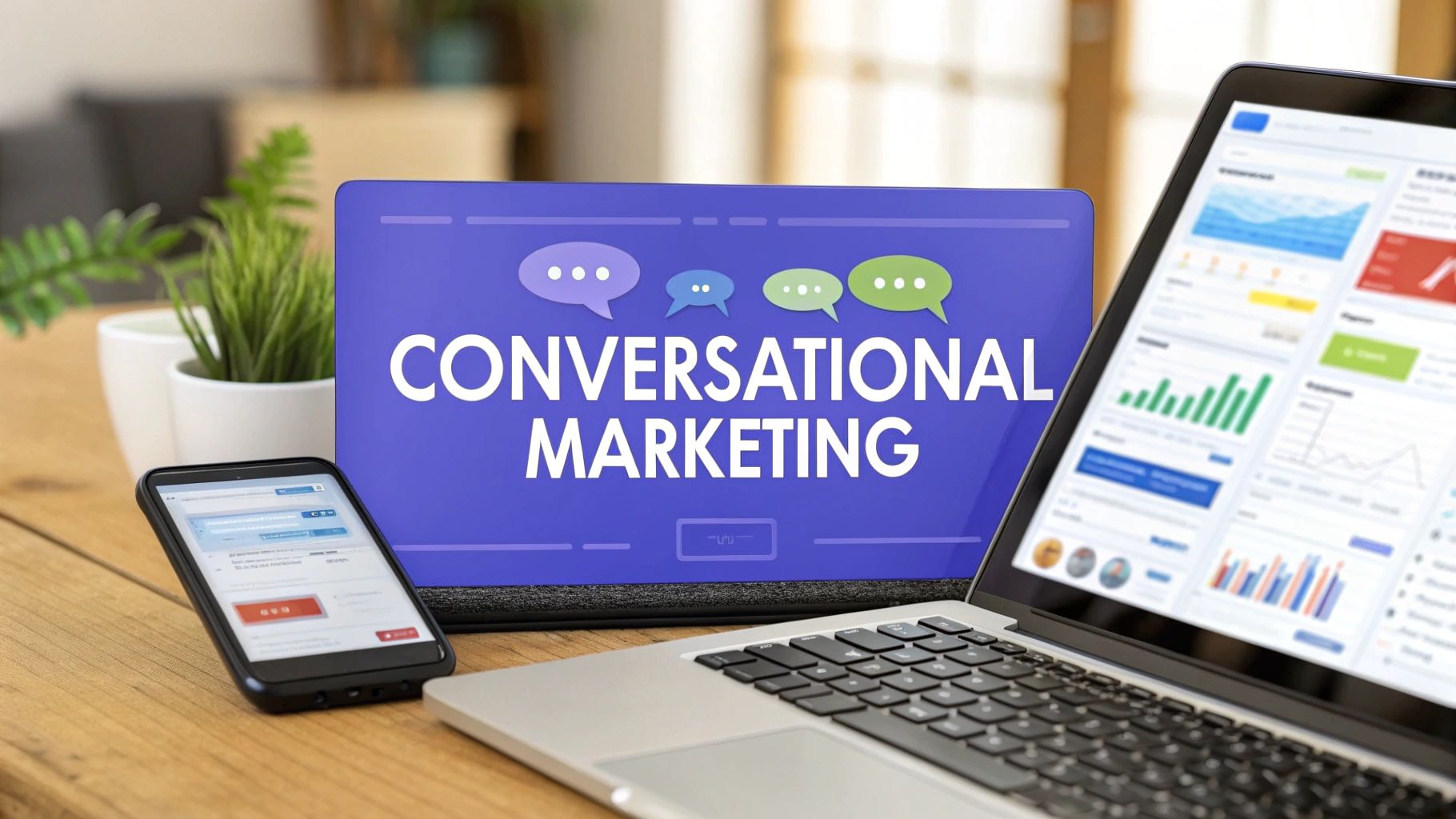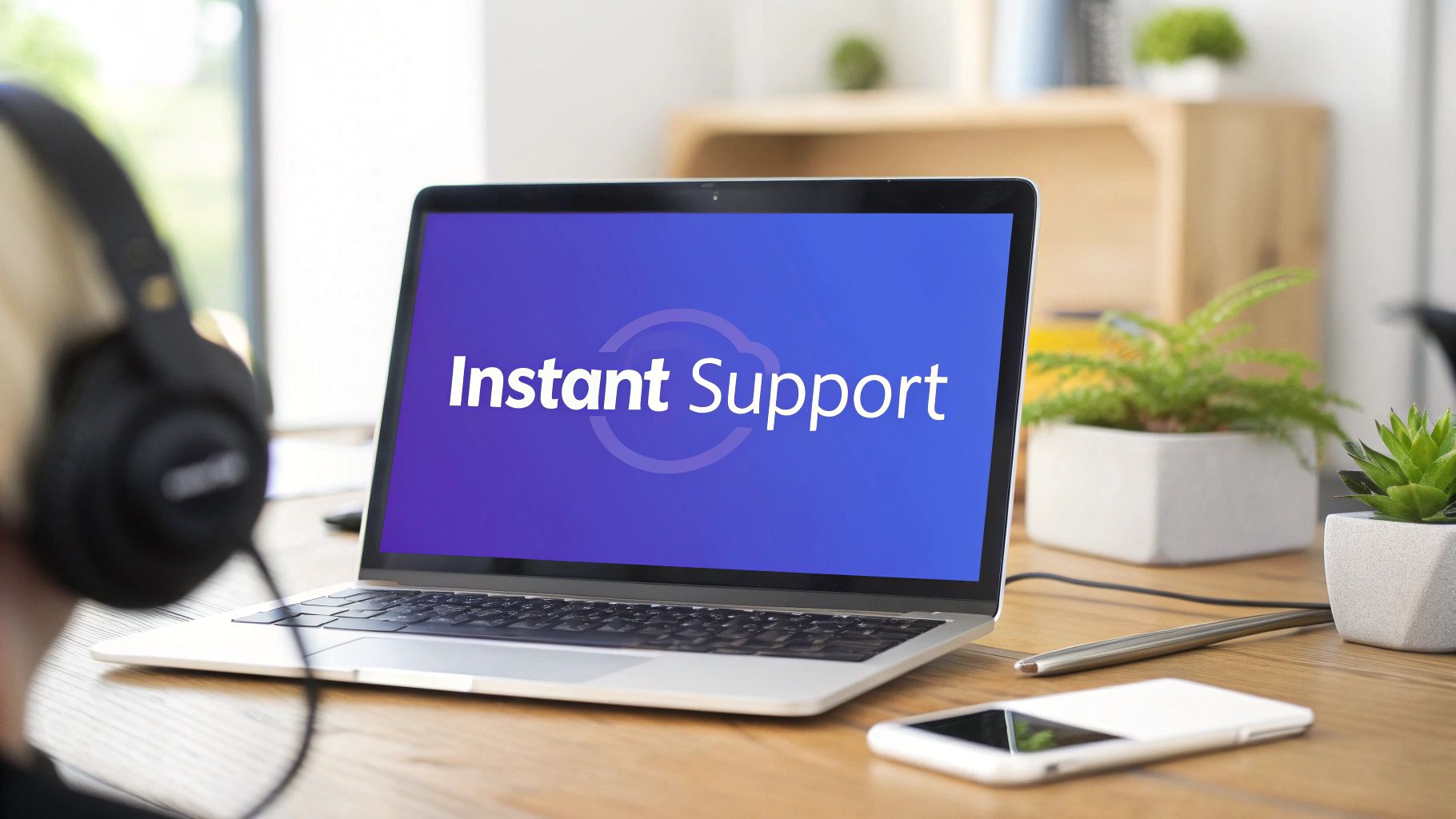8 Useful Sample Welcome Messages for Any Situation (2025)
Need sample welcome messages? Here are 8 customizable templates and examples for emails, chatbots, and onboarding to make a great first impression.
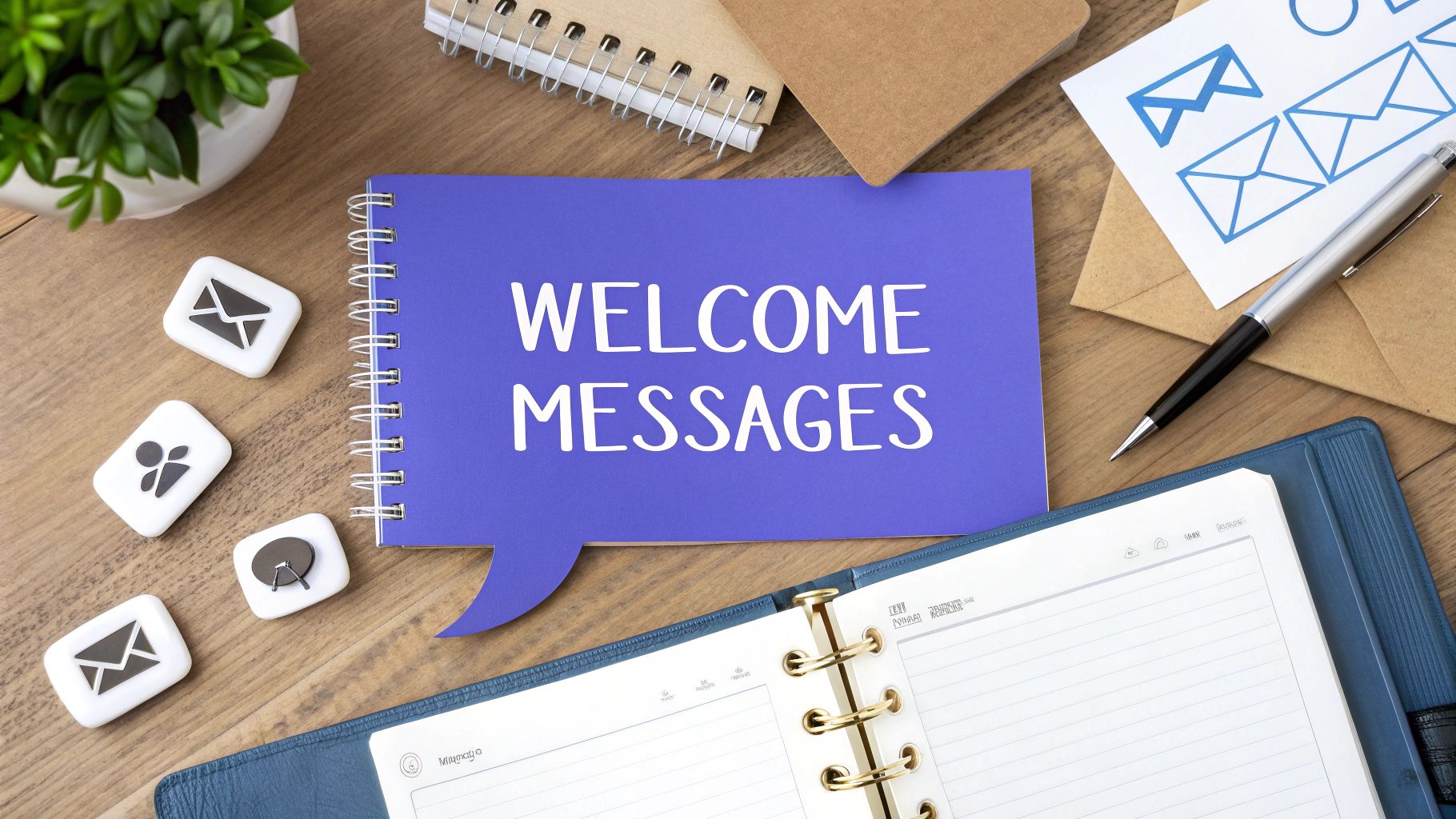
Getting a welcome message right is a big deal. It is your first real conversation with a new user, customer, or community member, and it sets the tone for your entire relationship. A good one makes people feel seen and confident they made the right choice. A bad one might cause them to tune you out completely. This is especially true for email, where the initial interaction can make or break future engagement. For a complete look at how to shape your email communications, including welcome messages, to get great results, consult this guide on proven personalized email strategies.
This guide moves past generic templates. We will show you 8 different strategic approaches to crafting effective sample welcome messages. We will explain the psychology behind why they work and give you actionable examples you can adapt for your own business. You will learn how to write messages that connect with people, clearly guide them to their next step, and show them the value you offer from the very beginning. From personal and value-driven messages to those focused on community or storytelling, you will find a blueprint to create a powerful first impression that lasts.
1. The Personal Welcome Message
The personal welcome message is a powerful first touchpoint designed to make a new user, customer, or connection feel individually seen and valued. By moving beyond generic greetings and using specific details, this type of message establishes an immediate human connection, which can significantly improve engagement and build brand loyalty from the very beginning. It signals that the recipient is not just another number in a system but a person worth acknowledging.
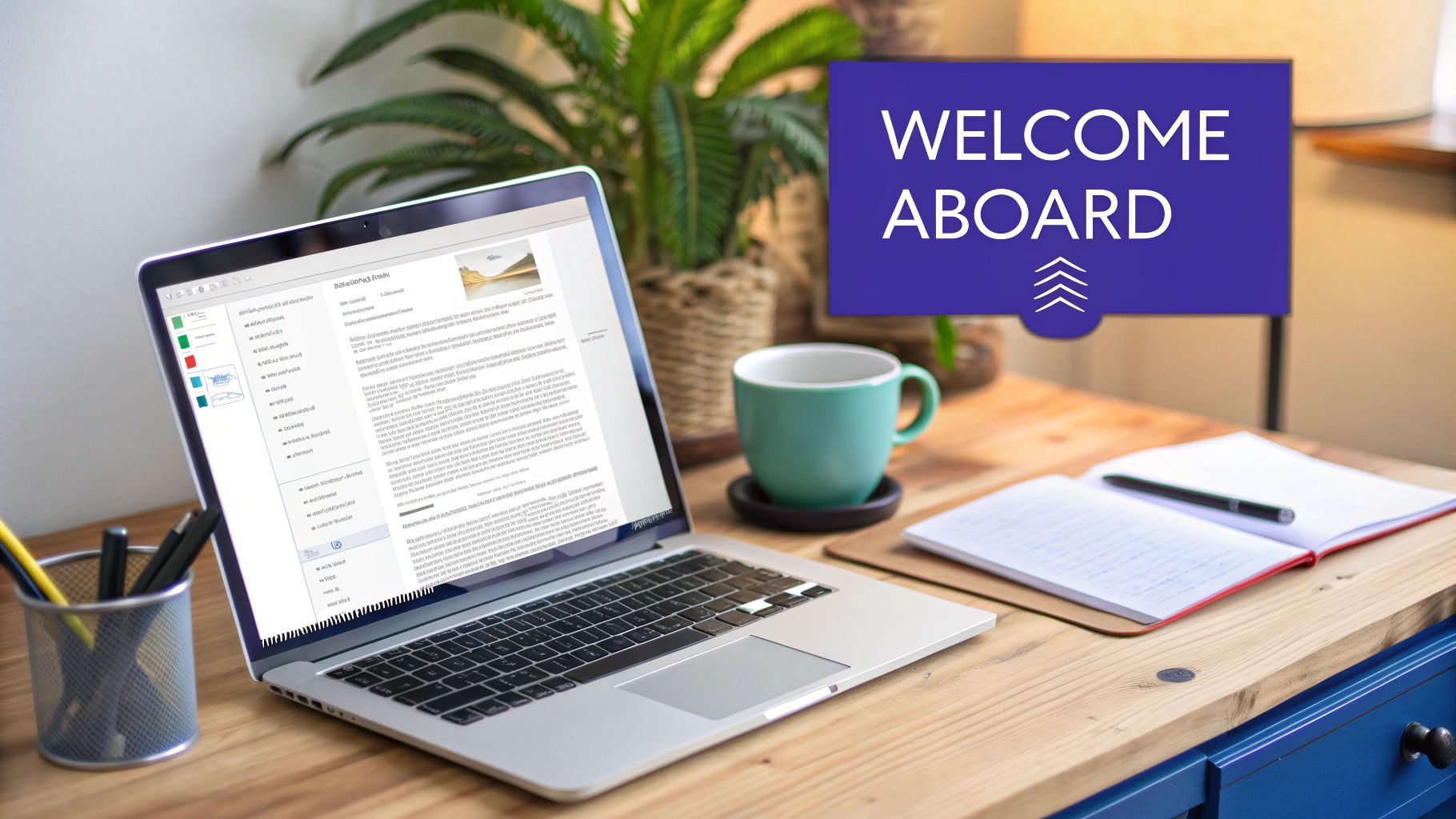
This approach is highly effective because it uses basic psychology: people respond positively when they are recognized. Companies like Shopify excel at this in their merchant onboarding emails. They do not just say "Welcome"; they say, "Welcome, [Merchant Name]! We're excited to help you build your [Store Type] store." This simple customization makes the experience feel supportive.
Strategic Analysis
The core strategy behind a personal welcome message is to create a sense of belonging and reduce the friction of a new relationship. When a user receives a message that references how they signed up or acknowledges their specific interests, it confirms they made the right choice.
Key Insight: Personalization transforms a transactional interaction into a relational one. Addressing a user by name is the baseline; referencing the context of their arrival (e.g., "Thanks for joining us from the webinar, Sarah!") demonstrates genuine awareness and appreciation.
This method directly impacts user retention. A person who feels recognized from the start is more likely to invest time in exploring a platform, completing their profile, or making their first purchase. It sets a positive precedent for all future communications. You can learn more about how this fits into a broader communication plan by exploring these automated email response examples.
Actionable Takeaways
To effectively implement personal welcome messages, focus on these tactical elements:
- Use Dynamic Fields: Use the recipient's name more than once. A good practice is to include it in the subject line and the opening sentence.
- Reference the Source: Mention how the user joined. For example, "Great to see you, David, after you downloaded our guide on project management."
- Provide a Clear Next Step: Guide them with a specific, singular call to action. Instead of a generic "Get Started," try "Upload your first project file here to see how it works."
- Maintain Brand Voice: Make sure the warmth and tone of the message align perfectly with your overall brand personality.
2. The Value-Driven Welcome Message
A value-driven welcome message immediately answers the new user’s most pressing question: “What’s in it for me?” This strategic approach moves beyond a simple greeting to reinforce the core benefits the user will gain. It sets clear expectations and highlights the tangible value of your product, service, or community, confirming their decision to sign up was a smart one.
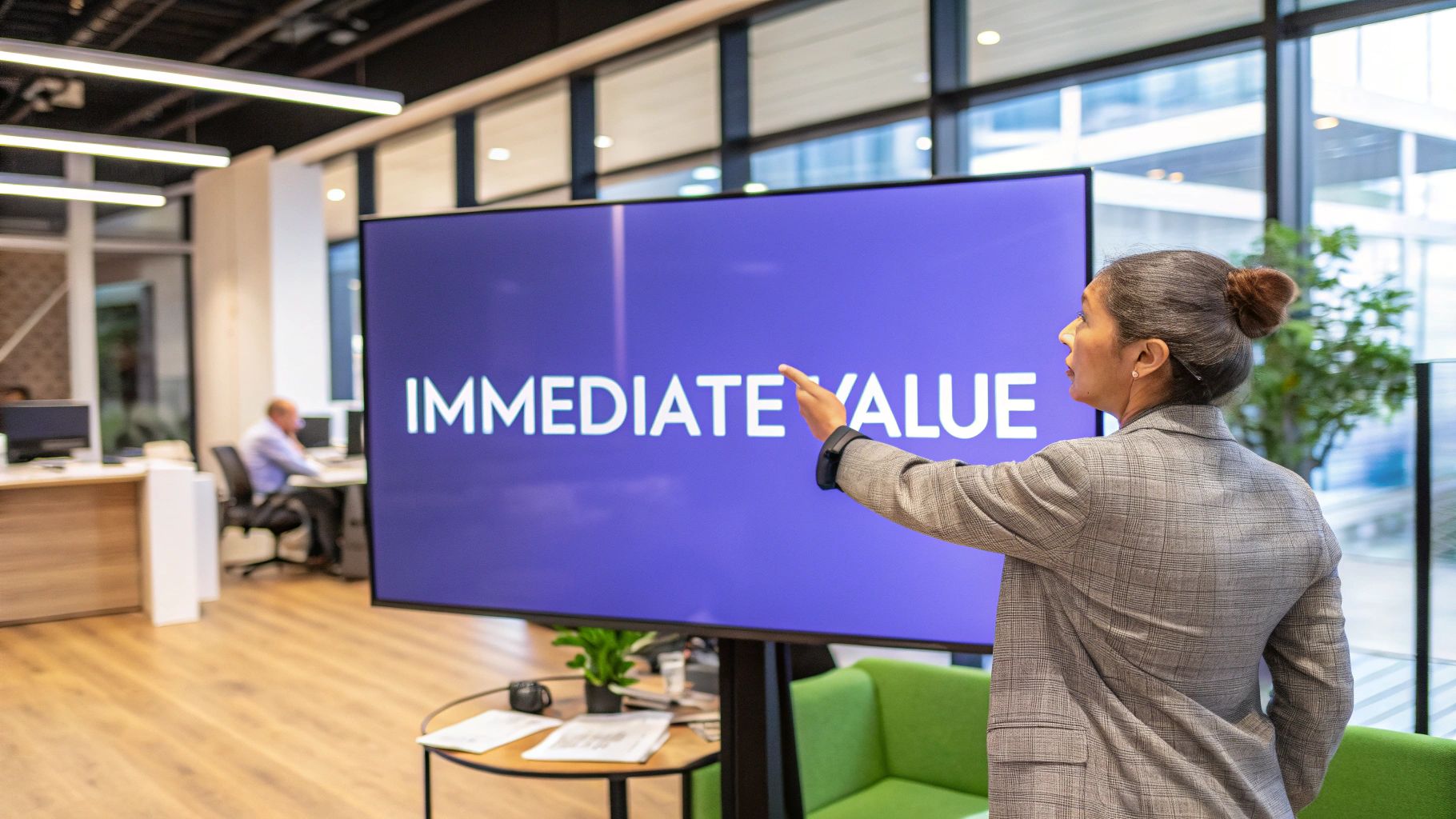
This method is highly effective because it combats instant buyer's remorse and reduces user inactivity. SaaS companies like HubSpot master this by sending welcome emails that do not just say hello, but immediately guide users to the features that will solve their biggest problems. For example, a message might highlight how to create a first marketing campaign to generate leads, directly linking the platform to a desired business outcome. This makes the promised value feel real and accessible from day one.
Strategic Analysis
The core strategy is to frame the onboarding experience around benefits, not just features. When a new user sees how your platform will make their life easier, they are far more motivated to engage. This message serves as a condensed version of your value proposition, delivered at the moment of highest user interest.
Key Insight: Early value confirmation is important for retention. A message that says, "You're one step away from saving 10 hours a week on reporting," is more powerful than one that says, "Click here to explore our dashboard."
Focusing on outcomes builds momentum. A user who sees a clear path to achieving their goals is less likely to abandon the platform after signing up. This technique turns the initial welcome into a powerful tool for user activation, making it a key component in any collection of sample welcome messages.
Actionable Takeaways
To create compelling value-driven welcome messages, apply these specific tactics:
- Lead with the Primary Benefit: Open your message with the single most compelling outcome the user can achieve. Make it the headline or the first sentence.
- Quantify the Value: Use specific numbers or metrics to make benefits tangible. "Join 50,000+ teams who ship projects 40% faster" is more persuasive than "improve productivity."
- Show, Don't Just Tell: Include a short GIF or a link to a quick tutorial that demonstrates a key benefit in action.
- Connect to a Pain Point: Frame the value as a solution to a problem they likely have. For instance, "Tired of scattered client feedback? Centralize it all here."
3. Step-by-Step Guide Welcome Message
The step-by-step guide welcome message is an instructional touchpoint that directs new users on exactly what to do next. This method removes ambiguity and helps users achieve an "aha" moment quickly, proving the value of your product or service right away. Instead of leaving users to figure things out on their own, it offers a clear, structured path to success.
This process-flow infographic illustrates the typical onboarding journey this type of welcome message facilitates.
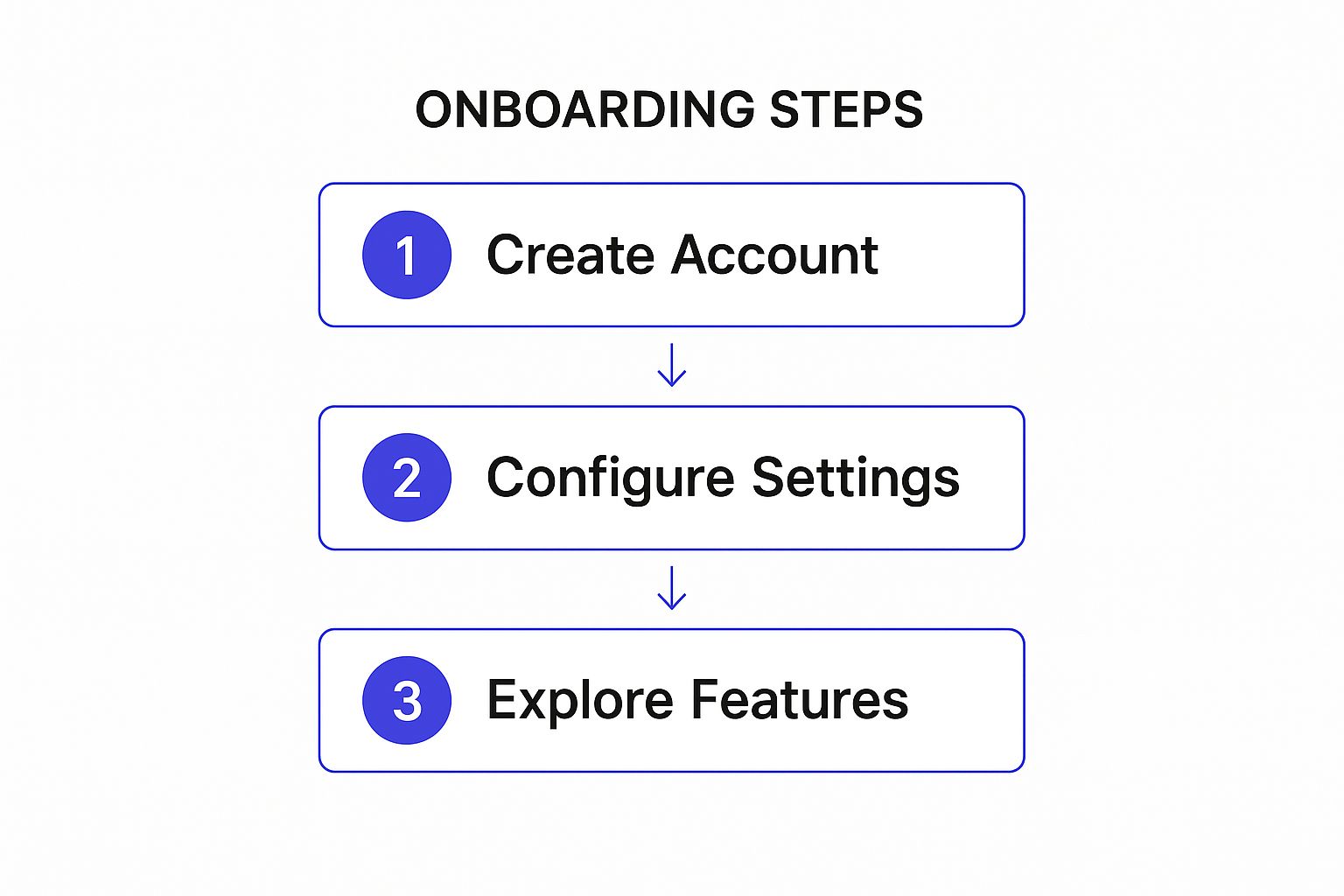
The visualization breaks down a complicated onboarding process into a simple, three-stage flow, guiding users from initial setup to active engagement. This approach is highly effective because it makes a new platform feel immediately manageable. Platforms like Notion and Canva use this strategy to guide users through initial actions, like setting up a workspace or creating their first design, which dramatically increases activation rates.
Strategic Analysis
The strategy behind a step-by-step welcome is to combat new-user paralysis and accelerate time-to-value. When someone signs up for a complex tool, they can feel overwhelmed. A guided welcome provides a curated experience, showing them the most important actions to take to see immediate benefits.
Key Insight: Structuring the first interaction as a clear, achievable to-do list builds momentum. Completing small tasks creates a sense of accomplishment and encourages deeper engagement with the platform.
This method directly impacts user activation and long-term retention. A user who successfully completes the initial steps is far more likely to integrate the tool into their regular workflow. You can find more information on building such structured user journeys by reviewing customer onboarding best practices.
Actionable Takeaways
To build an effective step-by-step guide in your welcome messages, concentrate on these elements:
- Limit the Steps: Start with just 3-5 critical actions to avoid overwhelming the user.
- Use Action-Oriented Language: Begin each step with a clear verb, like "Create," "Connect," or "Invite."
- Set Expectations: Mention the estimated time to complete the steps (e.g., "Get set up in under 5 minutes").
- Combine Text and Visuals: Use short text instructions paired with icons, screenshots, or brief GIFs to clarify each action.
4. The Community-Focused Welcome Message
A community-focused welcome message shifts the spotlight from a one-on-one interaction to the collective group, making new members feel they are now part of something bigger. This approach emphasizes shared values, common goals, and the social benefits of joining. It immediately frames the experience as a vibrant network of like-minded people.

This method taps into the fundamental human need for connection and belonging. Brands like Peloton master this by welcoming new riders not just to a piece of equipment, but to a global fitness community. Their messaging highlights leaderboards, group rides, and hashtags, which reinforces the idea that "we are all in this together." Similarly, a well-crafted welcome post in a Facebook Group or Reddit subreddit makes new users feel at home and encourages them to participate right away.
Strategic Analysis
The core strategy is to build a sense of identity and shared purpose from the very first interaction. By framing the welcome around the community, you create an environment where members feel motivated to contribute and engage with one another, which significantly increases long-term retention.
Key Insight: A community-focused welcome transforms a user from a passive consumer into an active participant. It changes the narrative from "What can this product do for me?" to "What can we achieve together?"
This approach is highly effective for building a self-sustaining ecosystem where members support each other. An active community becomes a powerful asset, providing social proof and reducing the support burden on the organization. You can discover more about building these connections by exploring various customer engagement strategies.
Actionable Takeaways
To create effective community-focused sample welcome messages, concentrate on these tactical elements:
- Use Inclusive Language: Employ words like "we," "us," and "our" to create a sense of shared ownership. Phrase the welcome as "Welcome to our community" instead of "Welcome to our service."
- Showcase Community Activity: Share a recent community success story, a popular discussion thread, or a member highlight to show the community is active and valuable.
- Provide a Participation Prompt: Give new members a simple, low-stakes way to introduce themselves, such as asking them to share what they hope to learn or what brought them here.
- Clarify Community Norms: Clearly and warmly state the community guidelines to set expectations for positive interactions from the start.
5. The Story-Driven Welcome Message
A story-driven welcome message moves beyond a simple greeting to share the mission, origin, or core values behind a brand. This narrative-based approach builds an immediate emotional connection by inviting the new user into a larger story. It helps them see the "why" behind the company, making them feel like part of a community rather than just a customer.
This technique is effective because humans are wired for stories. A compelling narrative creates context, builds trust, and makes a brand memorable. Companies like Warby Parker effectively use their story of disrupting the expensive eyewear industry to connect with customers. Their welcome messages often allude to this mission, framing the customer's purchase as a smart, conscious choice that challenges the status quo.
Strategic Analysis
The strategy behind a story-driven welcome is to establish a values-based connection that transcends the product or service itself. When a new subscriber learns about a company's commitment to sustainability, like Patagonia, or its journey from a small startup, they are more likely to become a loyal advocate. The narrative gives their decision to join more meaning.
Key Insight: Storytelling transforms a brand from a faceless entity into a relatable character with a purpose. The message should position the new user as a key character in the next chapter of that story, giving them a part in the mission.
This approach significantly boosts engagement and long-term loyalty. A customer who buys into the brand's story is less likely to switch to a competitor based on price alone. They have an emotional stake in the company's success. This is one of the more powerful sample welcome messages for building a strong brand identity from the first interaction.
Actionable Takeaways
To create an effective story-driven welcome message, concentrate on these elements:
- Identify Your Core Narrative: What is the most compelling aspect of your brand's journey? Is it a founding story, a powerful mission, or a unique problem you set out to solve?
- Make the User the Hero: Frame the story so the user's decision to join is a pivotal moment. For example, "By joining us, you're helping to..."
- Keep It Concise and Authentic: Tell your story in a few impactful sentences. Use a genuine, conversational tone that reflects your brand's personality.
- Connect to a Clear Action: End the story with a call to action that logically follows the narrative. For instance, if your story is about community, invite them to join your online forum.
6. The Exclusive Access Welcome Message
The exclusive access welcome message is a strategic communication that highlights the special status a new member has just gained. This approach goes beyond a standard greeting by framing their entry as an invitation into a select group, making the recipient feel privileged and smart for joining. It uses psychological principles of scarcity and exclusivity to generate immediate value and excitement, reinforcing the idea that they have unlocked something not available to the general public.
This method is highly effective because it immediately validates the user's decision to sign up. Companies like LinkedIn Premium master this by welcoming new subscribers with a message that details the advanced features they now possess, such as "See who's viewed your profile" or "InMail credits." This communication confirms the value proposition and encourages immediate exploration of the new, exclusive tools at their disposal. The message shifts the focus from a simple transaction to a status upgrade.
Strategic Analysis
The core strategy of an exclusive access welcome message is to increase perceived value and create a strong sense of belonging. When a user is told they are now part of a special community or have access to unique benefits, it taps into the human desire for status and inclusion. This feeling of being an "insider" can significantly boost initial engagement and long-term loyalty.
Key Insight: Framing access as a privilege transforms a passive user into an active and engaged member. The message should celebrate the user’s new, elevated status. It confirms they made an intelligent choice, reducing potential buyer's remorse.
This approach directly influences user behavior by motivating them to explore the perks they've just unlocked. A member who feels special is more likely to use the exclusive features, participate in the community, and ultimately, see the tangible value of their membership. This sets a positive foundation for renewal and advocacy. You can explore how this fits into your overall customer journey by reviewing these marketing funnel stages.
Actionable Takeaways
To effectively create exclusive access welcome messages, concentrate on these tactical points:
- Use Privileged Language: Employ words like "exclusive," "insider," "members-only," and "you're in" to reinforce their special status.
- Highlight Key Benefits Immediately: Clearly list the top 2-3 exclusive perks they can use right away. For example, "As a member, you now have access to our private resource library."
- Quantify the Exclusivity: If possible, mention the select nature of the group. For example, "Welcome to the club! You're one of only 1,000 founding members."
- Provide a Curated First Step: Guide them to an exclusive feature as their first action. Instead of "Explore the dashboard," try "Check out your first members-only report here."
7. The Question-Based Welcome Message
The question-based welcome message is an interactive approach that flips the traditional onboarding monologue into a dialogue. Instead of just pushing information, it pulls valuable insights from the new user by asking thoughtful questions about their goals, challenges, or preferences. This strategy makes the recipient feel heard from the very first interaction and immediately begins to shape their experience.
This method is powerful because it serves a dual purpose: it engages the user and simultaneously collects zero-party data that can be used for future personalization. Companies like Duolingo master this with their onboarding. Before a user even starts a lesson, the app asks why they want to learn a language. This simple question helps customize the learning path and frames the experience around the user's specific motivation.
Strategic Analysis
The core strategy behind a question-based welcome message is to build a user-centric experience founded on direct feedback. By asking questions, a company demonstrates that it values the user's input and is committed to helping them achieve their specific objectives. This transforms the onboarding from a passive process into an active, collaborative one.
Key Insight: Asking questions shows you care. When you ask a user what they want to accomplish, you are implicitly promising to help them get there, which builds trust and sets a positive tone for the relationship.
This approach significantly impacts engagement and long-term retention. A user who has shared their goals is more invested in the platform and more likely to see its value. It also allows for highly relevant follow-up communications, making every future interaction feel more personal and useful.
Actionable Takeaways
To effectively implement question-based sample welcome messages, focus on these tactical elements:
- Ask Purposeful Questions: Frame questions that genuinely help you serve the user better. For instance, a project management tool might ask, "What's the biggest challenge you face with your current workflow?"
- Keep it Brief: Limit the initial set of questions to a maximum of three to five. You want to gather information without creating friction or overwhelming the user.
- Explain the "Why": Briefly mention how their answers will be used. A simple line like, "Your answers will help us customize your dashboard" makes the user feel more comfortable sharing.
- Act on the Answers: Use the information you collect. Follow up with a customized email or a tailored in-app tour that directly addresses the needs they shared. This proves you were listening.
8. The Resource-Rich Welcome Message
The resource-rich welcome message goes beyond a simple greeting to provide immediate, tangible value to new subscribers or users. This approach delivers a curated package of useful content, tools, or guides directly in the first interaction. It effectively positions the brand as a helpful expert and gives the recipient a clear reason to engage from the start.
This method is powerful because it shifts the focus from the company to the customer's needs. Instead of just saying "welcome," you are saying "here are some tools to help you succeed." Companies like HubSpot master this by offering access to their marketing resource libraries in their welcome emails. This gives new leads actionable content immediately, demonstrating the value of their ecosystem.
Strategic Analysis
The strategy behind a resource-rich welcome message is to establish authority and build trust by solving a user's problem right away. By providing valuable assets for free, you create a positive first impression and incentivize the user to explore what else you have to offer. This approach front-loads the value of the relationship.
Key Insight: Providing immediate resources changes the dynamic from a sales pitch to a partnership. When users receive helpful templates or guides, they feel equipped and supported, making them more receptive to future communications.
This tactic directly supports long-term engagement. A user who downloads a useful checklist or watches an insightful tutorial is more likely to remember your brand and view it as a go-to source of information. These sample welcome messages are designed to be the first step in an educational journey, not just a transactional confirmation.
Actionable Takeaways
To create an effective resource-rich welcome message, concentrate on these tactical elements:
- Curate Relevant Content: Align the resources with the user's initial point of contact. If they signed up for a webinar on SEO, provide an SEO checklist or a keyword research template.
- Organize for Clarity: Do not just list links. Group resources under clear headings like "Getting Started," "Advanced Tactics," or "Useful Templates" to make them easy to navigate.
- Mix Quick Wins and Deep Dives: Offer a blend of resources. Include easily digestible content like checklists with more in-depth materials like ebooks or video courses to cater to different engagement levels.
- Frame the Value: Clearly state how each resource will help the recipient. Instead of "Download our guide," try "Use this guide to plan your next three months of content."
Welcome Message Styles Comparison
Putting Your Welcome Messages to Work
Throughout this guide, we have explored a variety of powerful sample welcome messages, each designed for a specific purpose and audience. From the warm, personal greeting to the structured, resource-rich onboarding sequence, the common thread is clear: a successful welcome is intentional. It does more than just say hello; it sets the tone for the entire relationship, manages expectations, and provides immediate, tangible value.
The real power of these templates is not in copying them word-for-word, but in seeing the strategy behind each one. A personal message builds an emotional connection, while a step-by-step guide offers clarity and reduces friction. A community-focused welcome creates a sense of belonging, and a question-based approach makes the user feel heard from the very first interaction.
Synthesizing the Strategies for Maximum Impact
The most effective welcome sequences often borrow elements from multiple approaches. You do not have to choose just one. Consider combining a friendly, story-driven opening with a clear, value-driven statement about what the user will achieve. Or, pair an exclusive access offer with a step-by-step guide on how to use it.
The key is to map your message to your primary goal for that first interaction.
- Goal: Reduce churn? Use a step-by-step guide to demonstrate value quickly.
- Goal: Increase engagement? A community-focused or question-based message works well.
- Goal: Build brand loyalty? A personal, story-driven welcome can create a strong connection.
Your Actionable Next Steps
To move from theory to practice, start by defining what you want a new user, client, or team member to feel, know, and do immediately after receiving your message. Do you want them to feel excited? To know where to find key resources? To complete a critical setup task? Answering these questions will guide your selection and customization of the sample welcome messages we’ve covered. For additional perspectives on crafting effective user communication, the ahead.love blog for more insights offers a wealth of information that can help refine your strategy.
The final piece of the puzzle is continuous improvement. A/B test different subject lines, calls to action, and tones. Monitor engagement rates and gather feedback. The perfect welcome message is not a static script; it is a dynamic conversation starter that evolves with your audience and your goals. By implementing these strategies, you transform a simple greeting into a powerful tool for building lasting, valuable relationships.
Ready to automate and personalize your welcome messages at scale? Chatiant allows you to build and deploy intelligent AI agents that can greet users on your website, provide instant answers in Google Chat, and guide new customers through onboarding. Turn your first impression into your strongest asset with Chatiant.
